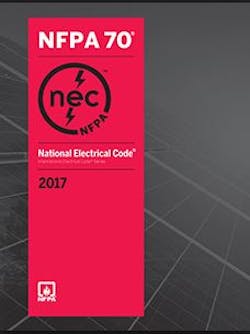PoE-related amendments proposed to the 2017 NEC
In early June the National Fire Protection Association (NFPA), which produces specifications including NFPA 70, the National Electrical Code, held its annual Conference and Exposition. Among the technical conference’s sessions was a panel discussion covering Power over Ethernet. (For more detail on the treatment of cabling for Power over Ethernet in the 2017 NEC, see “The intersection of remote powering technologies and the 2017 National Electrical Code” in the November 2016 issue of Cabling Installation & Maintenance magazine.)
Mark Earley, PE, the NFPA’s chief electrical engineer, led the panel discussion. Playing a prominent role in the discussion was Ernie Gallo, a director with Telcordia Technologies who also chairs the task group that was formed to provide input on Ethernet communications that could prompt some type of modification to the Code. Gallo reported that after 12 meetings in the form of conference calls, the 24-member task force had completed its work. The results of the group’s work will be to propose three tentative interim amendments (TIAs) to the 2017 NEC, and to provide approximately 10 public inputs to the 2020 NEC revision process.
The NFPA describes TIAs as “amendments to an NFPA standard [that are] effective only between editions of a standard. A TIA automatically becomes a public input for the next edition of the standard, and is then subject to all of the procedures of the standards development process.” Representatives of the NFPA explained that the three proposed TIAs are intended to enhance or ease usability of certain parts of the Code that address PoE.
In our November issue we reported the task group’s formation was prompted by an appeal made to the NFPA Standards Board specifically related to Section 840.160 of the 2017 NEC. The appeal’s basis was that Section 840.160 did not specify an ampere limit when citing 60-watt remote-powering circuits. The appeal pointed out that 60 watts can be arrived at as a product of an unsafely high amperage and some voltage. Presumably, the proposed TIAs will address this current-and-voltage issue as it exists in Sections 840.160, 725.144, and 725.121.
Keith Lofland, director of education for codes and standards with the International Association of Electrical Inspectors, also participated in the panel. During his presentation, Lofland pointed out that in preparation for his participation in the conference, he called several active electrical inspectors to gather their concerns about PoE—an inquiry to which he got little if any response. Lofland suggested, however, that his inquiry about PoE opened the eyes of two inspectors who later called him to report that PoE infrastructure was widespread within their jurisdictions.
The clear indication was that some inspectors have been seeing PoE infrastructure for some time but not realizing it. Lofland opined there is a need to educate inspectors about what PoE is, and how to identify cabling infrastructure that will support PoE.
Randy Ivans, program and project manager for wire and cable at Underwriters Laboratories, also presented as part of the panel discussion. He explained UL’s fact-finding investigation that ultimately led to the inclusion of Table 725.144 in the 2017 NEC.
Over the course of the panel presentations, as well as a later session in the exposition hall that continued the discussion, Ivans noted that despite the data collected in the fact-finding investigation, the data that exists about PoE and cable heating is a fraction of what could be discovered through further study.
For example, UL’s fact-finding investigation tested twisted-pair cables with conductor sizes as small as 26 AWG, and did not include patch cords. But 28-AWG cables and patch cords are available in the market today, and the Telecommunications Industry Association’s TR-42.7 committee currently is exploring the possibility of specifying 28-AWG cabling. As Ivans stated during the NFPA panel discussion, in PoE applications cable heating can be affected by, and managed via, AWG size among other characteristics—including cable design variations, material composition, and installation practices. The larger gauge the cable’s conductor, the less heat buildup a cable will experience, all other factors being equal. So 28-AWG cabling is presumed to be more prone to heat buildup than 26-, 24-, or 23-AWG cabling. Yet, as Ivans points out, empirical data is needed.
We will continue to follow the technological, standards, and code developments in this sphere and will report updated information.
